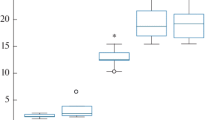Summary
Female RLEF1/Lati rats were chronically treated with 2-mercaptoethanol in a dose of 13 μg·100 g bw-1·day-1 dissolved in drinking water. During a 48-h experiment 15N-labelled glycine was given orally in a dose of 5 mg 15N·kg bw-1 and urine samples were collected and analysed by an emission spectrometric isotope method. Protein synthesis and nitrogen excretion rate constants were calculated according to the three-pool model, and 3-methylhistidine excretion rates were also determined. 2-Mercaptoethanol appears to influence protein metabolism; however, the slower rates of protein synthesis proved to be apparent in almost all groups of treated rats. Protein synthesis and nitrogen excretion rate constants have exceptionally high values in 2-year-old rats, possibly explained by the occurrence of hypercompensation mechanisms in old age. These were reflected by the excretion rates of 3-methylhistidine which were reduced as a result of sulphhydryl group interactions in age-dependent cellular metabolic changes.
Similar content being viewed by others
Abbreviations
- 2ME:
-
2-mercaptoethanol
- 3MeHis:
-
3-methylhistidine
- bw:
-
body weight
- HPLC:
-
high performance liquid chromatography
- SD:
-
standard deviation
References
Abe A, Sasaki T (1989) Sulphhydryl groups in glycolipid transfer protein: formation of an intramolecular disulphide bond and oligomers by Cu2+-catalyzed oxidation. Biochim Biophys Acta 985:38–44
Faust H, Bornhak H, Hirschberg K, Jung K, Junghans P, Krumbiegel P, Reinhardt R (1981) Klinisch-chemische und isotopen-analytische Methoden zur Untersuchung des Stickstoff-Stoffwechsels mit 15N beim Menschen (Methoden-Katalog) ZfI-Mitt, Leipzig, Heft 36
Fehér E, Pénzes L (1990) Effect of an antioxidant compound (2-mercaptoethanol) on the nerve terminals of the ageing small intestine. Exp Gerontol 25:135–140
Fettback G, Hellthaler G, Rotzsch W (1977) Zur Molekular-biologie des Alterns. 8. Mitteilung: Über das Altern intermitotischer Zellen. Altersabhängigkeit der Proteinsynthese in der Dünndarmmukosa. Z Alternsforsch 32:E231-E236
Gelfand RA, Hutchinson-Williams KA, Bonde AA, Castellino P, Sherwin RS (1987) Catabolic effects of thyroid hormone excess: the contribution of adrenergic activity to hypermetabolism and protein breakdown. Metabolism 36:562–569
Goldberg AL, Tischler M, DeMartino G, Griffin G (1980) Hormonal regulation of protein degradation and synthesis in skeletal muscle. Fed Proc 39:31–36
Harman D (1961) Prolongation of the normal lifespan and inhibition of spontaneous cancer by antioxydants. J Gerontol 16:247–254
Harman D (1983) Free radical theory of ageing: consequences of mitochondrial ageing. Age 6:86–94
Heidrick ML, Hendricks LC, Cook DE (1984) Effect of dietary 2-mercaptoethanol on the life span, immune system, tumor incidence and lipid peroxidation damage in spleen lymphocytes of ageing BC3F1 mice. Mech Ageing Dev 27:341–358
Hellthaler G, Fettback G (1977) Zur Molekularbiologie des Alterns. 12. Mitteilung: Gluthathion und der Einfluss von-SH-Reagenzien im Stoffwechsel alternder Zellen. Z Alternsforsch 32:567–573
Hellthaler G, Reifegerste D, Köhler R, Rotzsch W (1976a) Zur Molekularbiologie des Alterns. 6. Mitteilung: Veränderungen der Proteinsynthese im Alter. Z Alternsforsch 31:163–168
Hellthaler G, Reifegerste D, Köhler R, Rotzsch W (1976b) Zur Molekularbiologie des Alterns. 7. Mitteilung: Einfluss der Cytosolfraktion auf die Aminosäureinkorporation durch Rattenleber-Mikrosomen in Abhängigkeit vom Lebensalter. Z Alternsforsch 31:457–460
Hellthaler G, Reifegerste D, Rotzsch W (1977) Zur Molekular-biologie des Alterns. 9. Mitteilung: Altersabhängige Wirkung von 2-Mercaptoäthanol auf die Proteinsynthese im zellfreien System aus Rattenleber. Z Alternsforsch 32:121–125
Ichikawa M, Fujita Y (1987) Effects of nitrogen and energy metabolism on body weight in loater life on male Wistar rats consuming a constant amount of food. J Nutr 117:1751–1758
Jepson MM, Bates PC, Millward DJ (1988) The role of insulin and thyroid hormones in the regulation of muscle growth and protein turnover in response to dietary protein in the rat. Br J Nutr 58:397–415
Junghans P, Jung K, Matkowitz R (1984) Standardisierte 15N-Tracer-Methodik zur Bestimmung von Parametern des Ganzkörper-Protein-Stoffwechsels in der klinischen Praxis. Zfl-Mitt, Leipzig, Heft 88
Klug TL, Adelman RC (1979) Altered hypothalamic-pituitary regulation of thyrotropin in male rats during ageing. Endocrinology 104:1136–1142
Lewis SE, Goldspink DF, Phillips JG, Berry BJ, Holehan AM (1985) The effects of ageing and chronic dietary restriction on whole body growth and protein turnover in the rat. Exp Gerontol 20:253–263
Martin H (1989) Alternsbedingte Veränderungen der Protein-biosynthese. In: Beier W et al. (eds) Prozesse des Alterns. Akademie Verlag, Berlin, pp 156–184
McCarter RJ, McGee JR (1989) Transient reduction of metabolic rate by food restriction. Am J Physiol 257:E175-E179
Meier G (1986) Emissionsspektrometrische 15N-Analytik 1985. Isotopenpraxis 22:181–184
Munro HN, Young VR (1978) Urinary excretion of N-methylhistidine (3-methylhistidine): a tool to study metabolic responses in relation to nutrient and hormonal status in health and disease of man. Am J Clin Nutr 31:1608–1614
Noack R, Aust L, Pétzke KJ, Albrecht V (1988) Metabolic rate and protein synthesis. Wiss Z WPU Rostock, N-Reihe 37:100–101
Pénzes L, Noble RC, Beregi E, Imre S, Izsák J, Regius O (1988) Effect of 2-mercaptoethanol on some metabolic indices of ageing CBA/Ca inbred mice. Mech Ageing Dev 45:75–92
Pénzes L, Kranz D, Izsák J, Schubert K (1990) Relationship between heat-tolerance T4 and T3 hormones and thyroid morphometry in 2-mercaptoethanol-treated ageing mice. Z Alternsforsch 45:15–20
Pénzes L, Izsák J, Schubert K, Kranz D, Noble RC, Beregi E (1991) Effect of ageing on the thyroid in CBA/Ca inbred mice. Exp Gerontol 26:601–608
Petzke KJ, Pisarchuk KL, Medovar BJ, Tutelian VA, Junghans P, Albrecht V (1988) Protein metabolism in young adult and old rats in dependence on dietary protein content. Clin Nutr 7 [Suppl]: 69
Prothro J (1989) Protein and amino acid requirements of the elderly. Ann N Y Acad Sci 561:143–156
Spackman DH, Stein WH, More S (1958) Automatic recording apparatus for use in chromatography of amino acids. Anal Chem 30:1190–1206
Sprinson PB, Rittenberg D (1949) The rate of interaction of the amino acids of the diet with the tissue proteins. J Biol Chem 180:715–726
Tischler ME (1980) Is regulation of proteolysis associated with redox-state changes in rat skeletal muscle? Biochem J 192:963–966
Author information
Authors and Affiliations
Rights and permissions
About this article
Cite this article
Albrecht, V., Pénzes, L., Petzke, K.J. et al. Relationship between a long-term treatment of 2-mercaptoethanol and protein metabolism in the ageing rat. J Comp Physiol B 162, 547–551 (1992). https://doi.org/10.1007/BF00264816
Accepted:
Issue Date:
DOI: https://doi.org/10.1007/BF00264816




